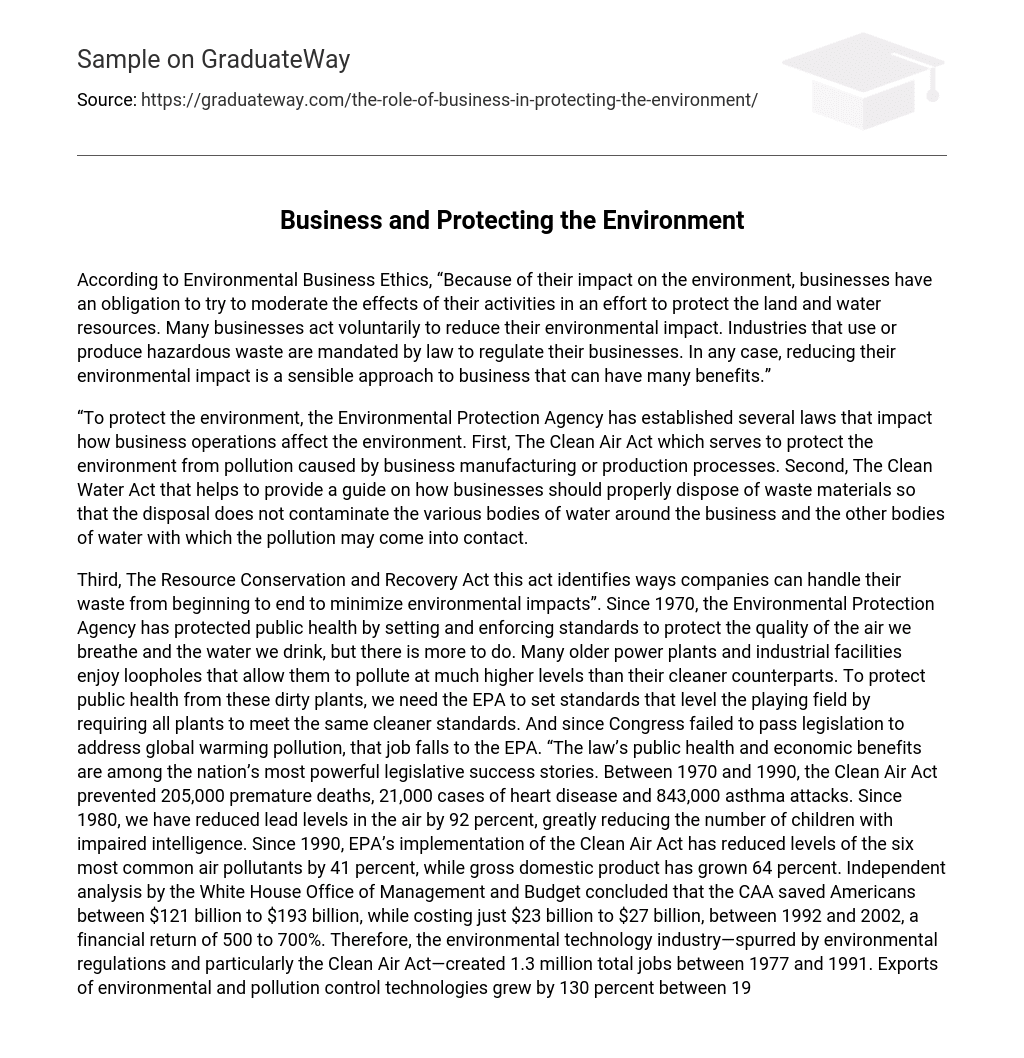According to Environmental Business Ethics, “Because of their impact on the environment, businesses have an obligation to try to moderate the effects of their activities in an effort to protect the land and water resources. Many businesses act voluntarily to reduce their environmental impact. Industries that use or produce hazardous waste are mandated by law to regulate their businesses. In any case, reducing their environmental impact is a sensible approach to business that can have many benefits.”
“To protect the environment, the Environmental Protection Agency has established several laws that impact how business operations affect the environment. First, The Clean Air Act which serves to protect the environment from pollution caused by business manufacturing or production processes. Second, The Clean Water Act that helps to provide a guide on how businesses should properly dispose of waste materials so that the disposal does not contaminate the various bodies of water around the business and the other bodies of water with which the pollution may come into contact.
Third, The Resource Conservation and Recovery Act this act identifies ways companies can handle their waste from beginning to end to minimize environmental impacts”. Since 1970, the Environmental Protection Agency has protected public health by setting and enforcing standards to protect the quality of the air we breathe and the water we drink, but there is more to do. Many older power plants and industrial facilities enjoy loopholes that allow them to pollute at much higher levels than their cleaner counterparts. To protect public health from these dirty plants, we need the EPA to set standards that level the playing field by requiring all plants to meet the same cleaner standards. And since Congress failed to pass legislation to address global warming pollution, that job falls to the EPA. “The law’s public health and economic benefits are among the nation’s most powerful legislative success stories. Between 1970 and 1990, the Clean Air Act prevented 205,000 premature deaths, 21,000 cases of heart disease and 843,000 asthma attacks. Since 1980, we have reduced lead levels in the air by 92 percent, greatly reducing the number of children with impaired intelligence. Since 1990, EPA’s implementation of the Clean Air Act has reduced levels of the six most common air pollutants by 41 percent, while gross domestic product has grown 64 percent. Independent analysis by the White House Office of Management and Budget concluded that the CAA saved Americans between $121 billion to $193 billion, while costing just $23 billion to $27 billion, between 1992 and 2002, a financial return of 500 to 700%. Therefore, the environmental technology industry—spurred by environmental regulations and particularly the Clean Air Act—created 1.3 million total jobs between 1977 and 1991. Exports of environmental and pollution control technologies grew by 130 percent between 1993 and 2003, and were valued at $30 billion in 2004.” Environmental Management System. An environmental-management system helps a facility monitor and control any activities that could impact the environment. It helps managements be more proactive about environmental issues, rather than merely react to them. There are certain beneficial aspects and impacts from using these systems: Reduced Costs, Competitive Advantage Better Regulatory Compliance and Performance “Environmental Business Ethics. Compliance Return on Investment Corporate Social Responsibility. Some businesses advance an aggressive environmental program because the leadership has determined that environmentally friendly practices are inherently good.
Boards of directors, sometimes under shareholder pressure, will adopt a “corporate social responsibility” agenda that, having identified environmental protection as an intrinsic good, commits the company to adopting green practices as part of the normal course of business. Some companies think advocating green practices may influence environmentally minded customers to prefer their products or services; the adoption of sustainability programs is thought to improve revenues as a result of improved consumer good will”. Reducing their environmental impact is a sensible approach to businesses that can have many benefits. Cost savings, Environmental awareness, and sends a good message to consumers. The following is an example of Arc International which is a brand of family-owned company the largest table top glassware producer in the world. “Making glass can be an environmentally harmful process. Every Arc facility engages in green efforts the following are a few ways they cut down their footprints at the Millville plant.
Over the last year, newly installed emissions scrubbers reduced the plant’s primary emissions by 75 percent. This move surpassed every environmental regulation making it the cleanest glass-manufacturing facility of its kind in the world, according to the EPA. The “Waste-heat recovery” this process aids in more efficient combustion, reducing emissions and energy usage. Other process is using recycled glass which reduces energy consumption by 5 to 10 percent. Also using organic inks is a cost saving factor. “45 percent of Luminarc’s decorated glassware is embellished using organic inks, which are free of heavy metals. Kontes says the ovens don’t have to be as hot or bake as long as with other inks to cure and bond the ink to the glass, resulting in further energy savings. In this article it is stated that this facts are a key reason Costco buyers are impressed by glassware manufacturer Luminarc.”
Bibliography:
Gillikin, Jason. eHow.com. 2013. web. 6 October 2013.
Medina, Hana. “Luminarc leads the way in green-sensitive manufacturing.” The Costco Connection October 2013: 47. Article. unknown. Natural Resources Defense Council. 2 December 2010. web. 6 October 2013.





